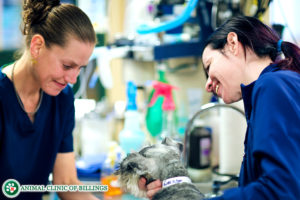Total Ear Canal Ablation (TECA)
What is a total ear canal ablation? (TECA)
The ear is comprised of inner, middle, and external portions. The inner ear is where sound waves are transformed into nerve impulses that are sent to the brain. The middle ear contains the tiny bones of the ear and the tympanic bulla, and is responsible for transmitting sound waves from the ear drum to the inner ear. The external ear contains the ear canal and the pinna (ear flap), and serves to receive sound waves and transmit them to the ear drum. A total ear canal ablation entails the surgical removal of the ear canal, the ear drum, and portions of the middle ear. A second procedure, called a bulla osteotomy, is performed at the same time in order to thoroughly clean out the middle ear and remove diseased tissue.
Why is the surgery performed?
Most of the time, a TECA-BO is performed to relieve pain and eliminate chronic infection in dogs that have suffered from protracted and/or recurrent ear infections that are no longer responsive to medical management. In these patients, the ear canal itself has usually become so narrowed and stiff due to chronic inflammation that adequate cleaning is no longer possible. Frequently, a severe infection is present that extends deep into the middle ear. TECA-BO surgeries are also performed in cases where a tumor is growing in the middle ear or ear canal. While the TECA-BO procedure does diminish an animal’s ability to hear, in most cases, patients undergoing this procedure already have significant hearing impairment as a result of their chronic ear disease, so the change in hearing observed by owners following the surgery is usually minimal.
What will the ear look like after surgery?
The cosmetic result following TECA surgery is excellent. The patient’s ear flap will appear the same as before, but the opening to the ear canal will no longer be present beneath it. Once the incision heals and the hair regrows after TECA surgery, it is very difficult to notice that surgery has been performed.
What is the post-operative care of TECA surgery?
Most dogs and cats recover quickly from ear canal removal surgery. Strict rest is advised on surgical patients for two weeks to ensure incision healing but most dogs and cats seem eager to return to full activity long before this period of rest is complete.
Are there any risks or complications?
Because multiple important nerves and blood vessels run very close to the anatomical structures involved in this surgery, it is important to be aware of several possible complications. Temporary damage may occur during TECA surgery to the facial nerve, which leads to a loss of the blink reflex in dogs and cats for two to four weeks. Because of this, eye lubrication is required during and after surgery to moisten and protect the dog or cats eye. Permanent facial nerve damage is possible but rare. Infection and/or abscess formation may occur up to two years after surgery; the risk of this occurring is 5 to 10 percent. Other less common complications can also include difficulty eating due to jaw pain and signs of inner ear disease (circling, head tilt, abnormal eye movement). Most of these complications resolve on their own with time and rest.

Let our highly trained and experienced team of veterinarians and veterinary technicians help you keep your cat as happy and healthy as they can be.
Call the Animal Clinic of Billings and Animal Surgery Clinic to schedule your pet cat’s next wellness examination with one of our veterinarians today!
406-252-9499 REQUEST AN APPOINTMENT



